
It focuses on recognizing more depreciation in the asset’s earlier years. You first calculate the sum of the digits of the asset’s useful life and then apply this fraction to the depreciable base. Accumulated depreciation helps you track asset wear and tear, plan for replacements, and stay compliant with tax rules. Without it, you might overstate profits or miscalculate the value of the asset, leading to inaccurate financial reports. Accumulated depreciation is the total amount of depreciation recorded on an asset since its purchase.
Straight line method explained.
For example, if you buy machinery for $100,000, expect it to produce 500,000 units, and estimate a $10,000 salvage value, the depreciation per unit is $0.18. If the machine produces 50,000 units in one year, depreciation for that year would be $9,000. This amount will be shown under accumulated depreciation in the books, reducing the value of the asset. If a business has been depreciating a machine for 3 years at ₹10,000 per year, the accumulated depreciation at the end of year 3 would be ₹30,000. For example, a logistics company managing a fleet of vehicles can use software to track depreciation across multiple assets, ensuring compliance and accuracy.

Example of a Gain on Sale of an Asset

For example, if you buy accumulated depreciation meaning equipment for $50,000 with a five-year useful life, the straight-line rate would be 20% per year. In the second year, depreciation applies to the new book value of $30,000 ($50,000 – $20,000), resulting in a $12,000 deduction. For example, if you buy equipment for $50,000, expect it to last 10 years and estimate a $5,000 salvage value. The deduction would come out to $4,500 each year for 10 years as depreciation expense.
AccountingTools
Note that the account credited in the above adjusting entries is not the asset account Equipment. Instead, the credit is entered in the contra asset account Accumulated Depreciation. Accumulated depreciation can be defined as the total amount of depreciation for a fixed asset that is charged to expense since that asset was acquired and made available for use. This means it is a negative asset account that offsets the balance in the asset account to which it is usually linked.
- Depreciation is necessary for measuring a company’s net income in each accounting period.
- The allocation of the cost of a plant asset to expense in an accelerated manner.
- Determining the useful life of an asset requires judgment and may vary based on industry standards or usage patterns.
- It is recorded on a company’s general ledger as a contra account and under the assets section of a company’s balance sheet as a credit.
- For the past 52 years, Harold Averkamp (CPA, MBA) hasworked as an accounting supervisor, manager, consultant, university instructor, and innovator in teaching accounting online.
Assume that a company purchased a delivery vehicle for $50,000 and determined that the depreciation expense should be $9,000 for 5 years. Each year the account Accumulated Depreciation will be credited for $9,000. Therefore, after three years the balance in Accumulated Depreciation will be a credit balance of $27,000 and the vehicle’s book value will be $23,000 ($50,000 minus $27,000). Accumulated depreciation is incorporated into the calculation of an asset’s net book value. To calculate net book value, subtract the accumulated depreciation and any impairment charges from the initial purchase Grocery Store Accounting price of an asset. After three years, the company records an asset impairment charge of $200,000 against the asset.

Other Information Regarding Depreciable Assets
Typically, there’s an original basis for every asset you have in use, equal to the original purchase price. Then, there’s accumulated depreciation or the value lost in the asset, which is considered an expense on your books. For that reason, the annual depreciation expense in year 3 must be limited to only $2,200. Straight-line depreciation is the most straightforward bookkeeping and commonly used method.



